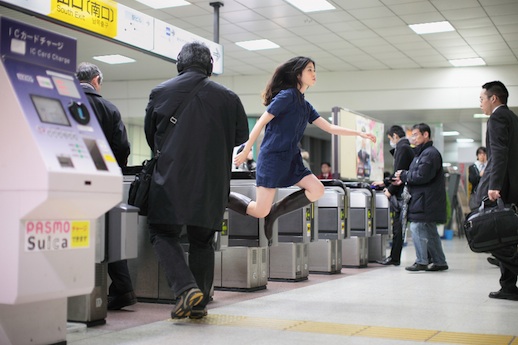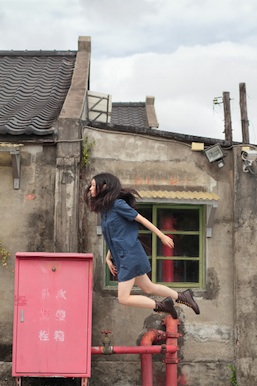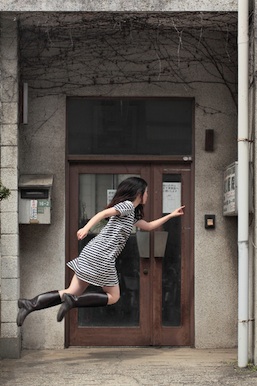Floating from blog to gallery
For an artist only now holding her first solo exhibition, Natsumi Hayashi has an impressive international reputation and fan base. Having risen to fame as an Internet sensation, her photoblog ‘Yowayowa Camera Woman Diary’ (A feeble, or weak, camera woman’s diary) has received much attention in the international press. To name a few, the New York Times, the MSN website, and the U.K. newspapers The Daily Mail and The Guardian are just some of the English language platforms where her work has been discussed in the last year or so. She has over 11,000 followers on Twitter and bilingual Google+ and Facebook pages, where she has active exchanges with her audience.
Based in Tokyo and working as a photographer’s assistant, Hayashi is best known for her series of ‘levitating’ self-portraits shot predominantly on an SLR camera and published extensively on her blog. ‘Today’s Levitation’, the exhibition currently being held at MEM in Ebisu, features original prints of these photographs, which have recently been published by IDEAfried Studio in the form of a monograph containing 80 to 100 images from the series (a Japanese version is available from Seigensha as of June 2012).

Hayashi started her website back in January 2011 and began posting the levitation images she had been taking as of autumn 2010, presenting them as a kind of fictional diary in amongst other images uploaded, such as those of her cats. Many of the photographs were shot in Tokyo, though there are also pictures that were taken in Taiwan and Florence. Unable to rely on having the opportunity to photograph these portraits daily, Hayashi uploads the images as and when she can, allowing herself time to select the best shots from each shoot and digitally retouch them. As an artist, she is very open about her technique for producing these works; the shooting method, ‘How to take “Today’s Levitation”’, is published on her website. In addition to this, her senior Hisaji Hara, who assisted her in taking a portion of the images by pressing the shutter release button, wrote the introductory text for the monograph, discussing the method used.
Though three of Hayashi’s images were shown in “Taiwan Photo 2011” for the first time in order to promote the book, published in December 2011, and eleven images are now on show at the MEM exhibition, arguably the best place to view Hayashi’s levitation series is online. When viewed on the Web, it is not only the time scale that is communicated well, but also the fact that the photographs are presented as personal documents or records. On the MEM website Hayashi writes:
I’m trying to express myself in the series as someone free from Earth’s gravitational pull. In being free of gravity in the photographs, I am also not bound to societal conventions. I feel as though I am not tied to many things and able [sic] to be my true self… It is clear that such my feeling [sic] is only an illusion, but I hope that the illusion can be converted into reality and fixed in the photographs piled up as a diary open to the public.
Unfortunately this is something that the current exhibition fails to really capture. In the transfer of the images from online to the book format by way of a gallery show, the underpinning context has been lost a little along the way. This is to say, when viewed in isolation and not as part of a diary project the images are under threat of coming across as too whimsical or gimmicky. This is not to say that the exhibition isn’t well worth a visit, as the original prints are excellent to see in large format, but the show needs to be understood as one element of an overarching concept. Though the blog is not updated in real time, Hayashi’s goal is to eventually upload 365 photos and come full circle. Time and continuity, and the tension between reality and fiction, are clearly important tenets of her work and arguably her commitment to producing this series is what makes the individual images credible.


In addition to her single frame portraits, Hayashi also produces some photographs to be presented in three-dimensional pairs, inspired by nineteenth-century stereoscopic photography. Shot on two identical cameras set up next to each other (just like a pair of eyes), these pictures are taken at the exact same moment and are presented side by side at the gallery. One highlight of the MEM exhibition is the chance to see one of these so-called pairings in large format. In order to experience them in 3D you need to focus your eyes intently on the two pictures until they blur and converge into a single image. Following this, if you begin to unfocus your eyes the 3D image should emerge out of the 2D background, in a way similar to the classic ‘Magic Eye’ 3D viewing technique. Considering that the exhibition is rather small and only presents such a small part of the series, the inclusion of the 3D pairing is a nice touch, and it certainly doubles the time you may want to spend in the gallery space.
Furthermore, if you want to catch another taster of her work, Hayashi is also currently featured in the group show “Shibuya Futurists Manifesto” at the Bunkamura Gallery in Shibuya, which runs from June 23 to July 4, 2012.
Jessica Jane Howard
Jessica Jane Howard



